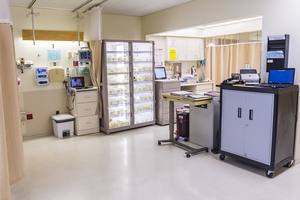Recovery
 Recovery Room
After your surgery you will be moved to the recovery room, also called the post anesthesia care unit (PACU). You will be closely monitored as the anesthesia wears off. When you are ready, you will return to your room or be discharged home.
Recovery Room
After your surgery you will be moved to the recovery room, also called the post anesthesia care unit (PACU). You will be closely monitored as the anesthesia wears off. When you are ready, you will return to your room or be discharged home.
How will I feel?
- Medications may be offered to reduce nausea if you experience nausea or vomiting during surgery.
-
You might have a mild sore throat after surgery. This may be caused by the airway or tube placed in your mouth during anesthesia.
- If you had an intravenous needle in your arm or hand, it may result in some discomfort. Any soreness or black and blue marks from needles should disappear in a few days.
- Some patients may wake up with a small tube (catheter) in their bladder. This is temporary and easily removed by your health care provider.
- Because of the anesthesia, you wont remember much about your operation.
- You might be unsteady on your feet. The doctor or nurse will tell you when to try to walk.
Your Role in Recovery
Your role is to become active as soon as possible and gradually increase your activity, while giving yourself time to heal. Rest when you feel tired. To speed recovery, you may be asked to cough, breathe deeply or undertake mild physical activity. A nurse will explain.
Deep breathing and coughing will keep your lungs clear, aid circulation and help prevent pneumonia. The first time you are asked to cough will be the hardest. Depending on your surgery, try holding a pillow over the incision for support. Tips for breathing and coughing are as follows:
- Slowly breathe in through your nose until you feel your belly balloon out.
- Press your lips together, tighten your stomach muscles, and blow air out.
- On the third deep breath, instead of breathing out the air, cough.
- Repeat this several times each hour.
Ankle Circles
- Lie on your back with legs apart, toes pointed up.
- Slowly turn feet outward, then slowly turn back toward each other. Turn in bed and change position often.
Incision and Dressing Care
After your surgery, you may have an incision covered by a bandage or dressing. There may be a tube in the incision to drain extra fluid. A nurse will demonstrate how to care for your incision and the dressing. Tips to help your incision heal quickly are as follows:
-
To help prevent infection, wash your hands before and after touching the incision area.
- Keep the incision area clean and dry.
- Take warm showers instead of baths.
Caring for Your Incision:
Change the dressing as instructed by the nurse or your doctor.
Check your incision for signs of infection, which include:
- Redness
- Swelling or hardness
- Warmth
- Odor
- Pus
- Keep your dressing dry
Call your doctor is you have any of these signs of infection.
Pain Management
Our goal is to make this experience as comfortable as possible, but we need your help. If you have pain after surgery, tell your nurse right away. Do not wait until the pain becomes severe. Medications for pain can be either “over the counter” or prescription drugs. If you are an inpatient, your pain medications may be pills or may be given through an IV. Our goal is to help you control pain and function at the highest level possible. Surgery is not pain free, but it is important you feel as comfortable and in control as possible.
Tips for Taking Pain Medications:
- Always take your medications as directed. Be sure to take the correct dose at the right time. This can help the pain before it starts.
- Do not stop taking the medication without asking your doctor.
- Call your doctor if you start to have side effects from the medicine.
- Tell your doctor if you drink alcohol- it may be dangerous if mixed with many medications.
Other Ways to manage pain:
- Massage
- Relaxation
- Heat or cold treatments
- Change of position
- Soothing sounds or music
- Diversionary activities
Help the Doctors and Nurses "Measure" Your Pain
They may ask you to rate your pain on a scale of 0 to 10. A score of “0” would mean no pain. A score of “10” would mean the worst pain ever. Reporting your pain as a number helps doctors and nurses know how well your treatment is working. They can then decide whether to make any changes in how your pain is being controlled. If your pain can not be completely eliminated, you will be asked to tell us your target pain level, you would be comfortable with.
Pain That Does Not Go Away
Tell the doctors or nurses about any pain that won’t go away. We want you to achieve a comfort level that is right for you. Our nurses and doctors want to make your hospital stay as pain free as they can. The amount or type of pain you feel may not be the same as others feel, even those who have the same problem. You are the key to getting the best pain relief, because the pain is personal. Your doctors and nurses need to be told if your pain is not being controlled.
